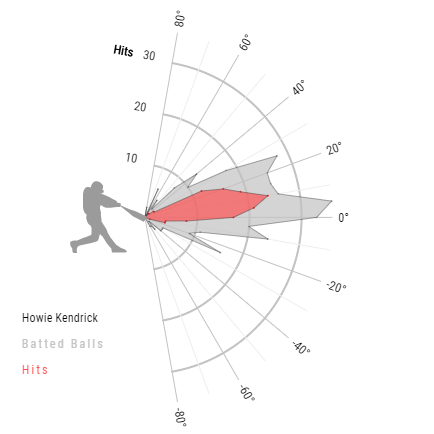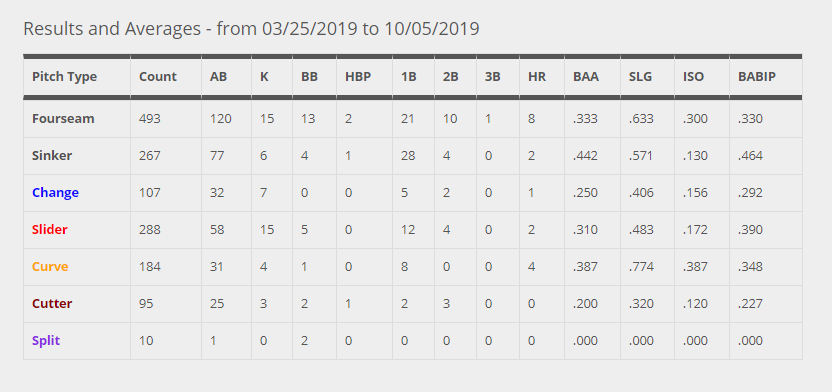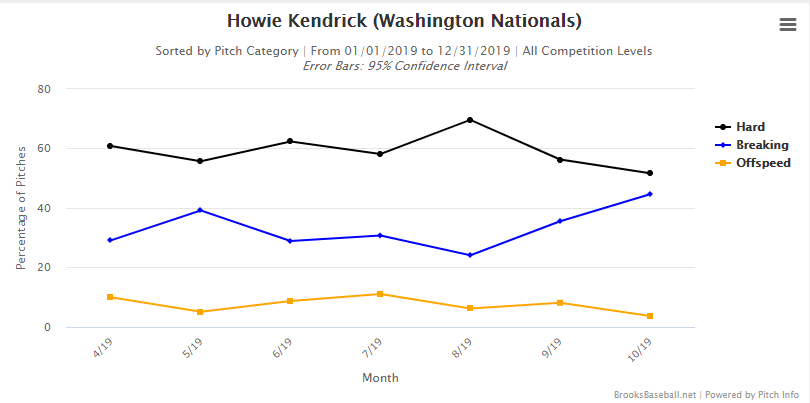Down one, a runner on first base. It’s Game Seven of the World Series. The NLDS? Crushed it, to the tune of a tenth inning grand slam in the deciding Game Five. The NLCS? MVP, with an OPS of over a thousand. This is the moment every kid dreams about growing up. This is a chance to be the hero.
Will Harris, who’s been excellent all year and has an ERA under 1.00 for the postseason, enters the game with Kendrick at the plate. Strike one, off-speed, and already the count is in the pitcher’s favor.
And then a fastball, one that Robinson Chirinos could have beautifully painted on the outside corner, had it made it to his glove. Instead, the fastball gets hammered down the right field line, landing just inside the foul pole. In a single swing, Howie Kendrick had become a World Series legend.
https://gfycat.com/anyboilingjanenschia
Kendrick’s legend didn’t simply happen during the playoffs last year. Beyond just the postseason, he performed at a spectacular level. Throughout the year, Kendrick was at the top of the league both when looking at traditional numbers and advanced statistics.
| Year | AVG | OBP | SLG | xBA | Hard Hit % | K% | Launch Angle |
|---|---|---|---|---|---|---|---|
| 2016 | .255 | .326 | .366 | .279 | 42.1 | 17.7 | 1.6 |
| 2017 | .315 | .368 | .475 | .293 | 34.0 | 20.4 | 0.8 |
| 2018 | .303 | .331 | .474 | .280 | 44.4 | 18.1 | 7.9 |
| 2019 | .344 | .395 | .572 | .336 | 48.3 | 13.2 | 11.0 |
Often, when a player has a league-leading batting average (Kendrick would have led the league, had he qualified), the xBA is significantly lower. It’s rare for a player to be a true talent .330 hitter, after all. When a player hits for that high an average, they nearly always experienced exceptional luck over the course of the season. This is not to say they are not still extremely good hitters; they just don’t tend to be as good as the numbers they produce.
Christian Yelich, for example, hit .329 last year, but had an xBA of .314. Tim Anderson, who led qualified hitters in batting average last season, had an xBA of only .294. Both players had great seasons, but Yelich got a little lucky and Anderson probably saw an increase of about 40 points in batting average due to luck.
Players who have an xBA significantly over .300 are few and far between: Only seven hit at least .310 by the metric, and that shortlist features players such as Bellinger, Betts, and Trout. Essentially, it’s exceedingly rare to put up a batting average north of .310 and not get extremely lucky.
Last year, Howie Kendrick hit .336 by the metric and led the majors in xBA by a full 13 points. That wasn’t a total outlier for Kendrick. While he obviously hasn’t hit at a .336 rate, he has consistently reached marks above .280, meaning he has long had a high batting average floor.
xBA was far from the only metric that liked Kendrick’s profile last season. Kendrick hit the ball hard 48.3% of the time, good for the 94th percentile of all hitters. He brought his strikeout rate down to 13.2%, also near the top of the league and less than half of many hitters’ rates. This was driven by a substantial decrease in whiff percentage, as Kendrick brought his zone contact up to elite levels.
The most interesting of the metrics that shows Kendrick’s improvement, however, is Kendrick’s improvement in launch angle.
For years, Howie Kendrick performed despite pounding the ball downwards into the ground. His 2017 launch angle of 0.8 degrees was a full 12 degrees lower than the league average of 12.8. Kendrick was making a lot of contact, and much of it was still decently well hit, but ground balls have a BABIP of .236 — combine that with the rarity of a ground ball ending up an extra-base hit, and a plate approach that pounds the ball into the ground is far from optimal. In 2018, Kendrick’s launch angle rose dramatically, all the way up to 7.9 degrees. Last season it was at 11.0 degrees, which was near league average. As the balls Kendrick hit well started leaving his bat at a more optimal trajectory, Kendrick started getting more extra-base hits.
| Year | ABs | Launch Angle | Extra-Base Hits | Extra-Base Hits per 650 ABs |
|---|---|---|---|---|
| 2017 | 305 | 0.8 | 28 | 59.7 |
| 2018 | 152 | 7.9 | 18 | 77.0 |
| 2019 | 334 | 11.0 | 41 | 79.8 |
As it turns out, pounding the ball into the dirt isn’t conducive toward hitting home runs. Launch angle has proven to be extremely sticky and batter dependent, meaning that Kendrick should be able to continue this trend; a good sign for his continued production.
Launch angle is an average statistic, meaning it looks at the average launch angle a batter hits for. A ball hit at a 40-degree angle is likely a pop out, while a ball hit at 0 degrees is typically a ground out, but the average of those two batted balls would lead to an excellent looking 20-degree average launch angle. Consistency in launch angle can have even more importance than average launch angle. Fortunately, Kendrick had a spread in launch angle last year that didn’t raise any red flags.
The shift in launch angle wasn’t the only reason behind Kendrick’s remarkable success last year. While Kendrick made good contact with all manner of pitches last year, Kendrick largely reached the heights he did because of otherworldly results against fastball-type pitches like four-seamers and sinkers.
For the most part, this chart features small sample sizes, meaning it shouldn’t be treated as gospel. He did have a large enough sample against some pitches to infer some things, though. Looking at Kendrick’s numbers against four-seamers is eye-opening: an ISO of .300, a batting average of .333, excellent slugging, all on a sustainable BABIP. This isn’t a fluky result of 120 ABs either. Kendrick has hit fastballs well his entire career, with his highest career marks in nearly every statistic coming against the pitch. His career batting average against fastballs is over .300, and that’s before factoring in the gains he’s made in areas such as launch angle.
Kendrick is far from helpless against other pitches — the numbers he put up against curveballs last year are especially impressive, albeit in 30 ABs — but he hasn’t historically hit them nearly as well as he has fastballs. When looking at numbers this small, it’s helpful to look at Kendrick’s results for his career. Kendrick’s batting averages against individual off-speed and breaking pitches range from .231 and .286 and he doesn’t hit any of them with notable power.
Unfortunately for Kendrick, by the end of last season, teams were beginning to understand how better to pitch against him.
In the last two months of Kendrick’s year, opposing pitchers sharply increased the number of breaking balls they threw. While the ABs Kendrick accumulated over last season often led to small sample sizes, these pitch counts garnered a fairly large sample as Kendrick faced over 500 pitches in the last two months. The trend may very well continue to occur as well: While at one point pitchers would almost exclusively pitch with their fastball and play off it with their other pitches, pitching philosophy is beginning to change. More often, teams have started to allow their pitchers to work backward through some of their matchups.
This has caused pitchers to throw more breaking balls to all batters, not just Kendrick. Eno Sarris wrote this article on the trend back in 2016 and, for a deeper dive, chapter seven of “The MVP Machine” by Ben Lindbergh and Travis Sawchik is excellent. The trend towards more breaking balls and off-speed pitches has only increased in conjunction with the rise of programs like Driveline helping organizations realize that these pitches are often a pitcher’s greatest weapon.
If the trend toward Kendrick facing more breaking balls continues, then his numbers last year, as excellent as they were, will not be wholly predictive of his performance in the future. Towards the end of the season, Kendrick began to face around 50% hard pitches instead of the 60% he had faced for most of his career. For a hitter as good as Kendrick is at facing fastballs, that shift will have an effect on his performance.
| Pitch Type | AVG | SLG | xBA | Exit Velocity | Whiff% |
|---|---|---|---|---|---|
| Fastballs | .363 | .591 | .363 | 92.7 | 10.2 |
| Breaking | .337 | .593 | .293 | 90.1 | 28.8 |
| Off-speed | .242 | .394 | .279 | 87.7 | 27.0 |
If breaking balls and off-speed pitches make up half of the pitches he faces, then his batting average will likely be closer to the .290 he deserved facing them than the .363 he hit off of fastballs. Even if the new pitch mix lessens Kendrick’s ability to hit fastballs, as he’s no longer able to expect them quite so often, he should have a floor in the range of his numbers against breaking balls and off-speed pitches. This exercise in looking at Kendrick’s numbers against individual pitches proves why it’s unhelpful to take advanced statistics at face value as a predictive measure. Numbers such as xBA are reflective and not predictive. When Kendrick had an xBA of .336 last year, that number shows that he deserved a batting average of .336 last year and means nothing about this year.
Even with that relatively high hitting floor and huge hitting ceiling, one of the biggest knocks against Kendrick has typically been his lack of reliable playing time. Last year Kendrick only received 334 ABs. Fortunately for Kendrick, however, there is reason to believe this year may be different. Ryan Zimmerman recently opted out of playing this year. He had played first base, which is one of two positions Kendrick plays in the field. While Eric Thames projects to start most days at first, now Kendrick will have the chance slide there on Thames’ off days.
More importantly for Kendrick’s playing time, the National League is instituting the DH this year. Roster Resource currently has Kendrick as the Opening Day starter there. Kendrick might not get full-time ABs, as the Nationals look to give all their players the occasional partial rest days and try to protect Kendrick from his injury history and age. Still, Kendrick’s opportunity to start most games is a welcome change.
Ultimately, Kendrick has the underlying statistics to show that last year was no fluke. Even as pitchers adjust to the new Kendrick, who drives the ball into the air, and throw more breaking balls, he should still be excellent. With Kendrick’s new playing time, he should be relevant in daily leagues, where a fantasy player can check to see if he’s in the starting lineup each day. If he is, his bat has enough quality to a garner a start in even 12-team mixed leagues. While it’s tough to trust Kendrick’s playing time enough to feel good about drafting him and expecting him to fill a starting role, drafting him for the first bench slot is an excellent option, especially with Kendrick’s eligibility at 1B, 2B, and 3B, two of which are shallow positions this year. Kendrick’s ADP in Yahoo is one slot after Robinson Chirinos, at 276, which makes him one of the bigger values at the end of drafts.
As for whether Howie can sustain his postseason success, the only conclusion to draw is that yes, Howie can.
(Featured image by Dorian Redden)





Great article! Looking forward to more by this author.